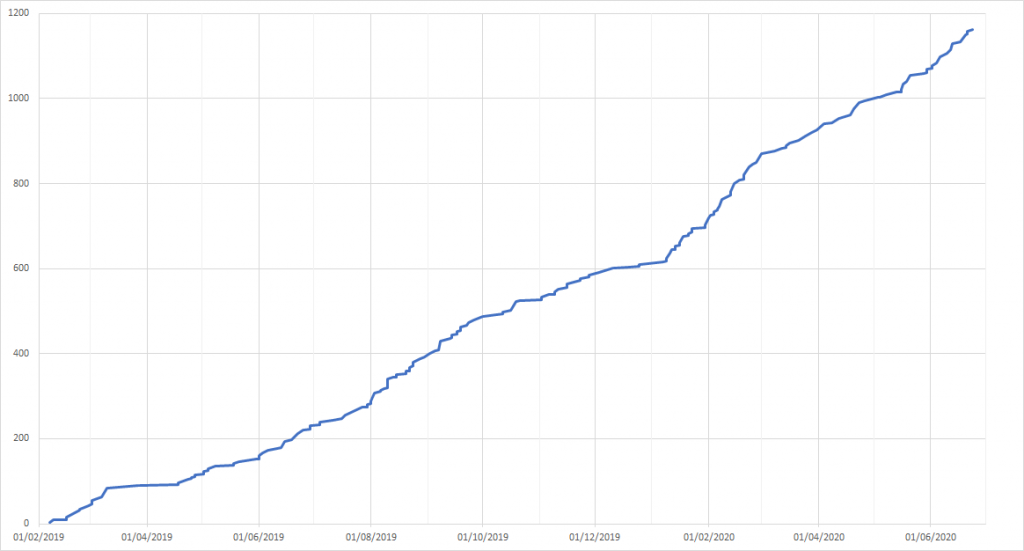So, not actually that far away, actually just a few metres away from where I am now, but fairly long ago. Back on the Easter weekend (10-13 April), I decided that since I had four days free and we were still near the start of lockdown and there wasn’t much to do outside, I would watch all of the Star Wars films over the four day weekend.
I then expanded this to include all of the Star Wars TV shows that were on Disney+, apart from The Mandalorian (because I was in the process of watching that separately) and anything that was Lego Star Wars (because that’s not canon). Whilst I’ve seen all of the films before, this is the first time I’ve watched any of these TV shows [side note: I was a fan of the previous, now non-canon Clone Wars TV series]. Last weekend I finally finished my challenge of watching them all in canon chronological order. Here’s my thoughts on each show/film:
Star Wars Episode I: The Phantom Menace (Lifetime watches: A lot)
Whatever anyone else says, this is clearly one of the best Star Wars films. It has so many quotable lines, it introduces the Jedi properly and has a load of new planets. Anyone who says Jar Jar is terrible should really be blaming Episode II where he becomes a recurring character – he was really just a one-off character in Episode I. It probably helps that I was 11 when this film came out and so was probably target market.
Star Wars Episode II: Attack of the Clones (Lifetime watches: A lot)
Another of my favourite films (you can tell I’m a prequels fan). I’m a big fan of clone troopers and this story is a great introduction to the clone wars series.
The Clone Wars (TV series) (Lifetime watches: 1)
This series is the reason why I didn’t complete my challenge in a four day weekend. With seven series leading to a solid 86 hours of watching, there was no way I could achieve my task. Once I realised it wasn’t possible, I slowed down quite a bit. Which is actually a good thing, because it turns out the 7th (and final) series hadn’t been fully released when I started, but I could now time my viewing activity with the new episode releases. This is my favourite of all the Star Wars TV series and I could easily watch much much more of the clone wars (if it was ever released).
Star Wars Episode III: Revenge of the Sith (Lifetime watches: Slightly less than a lot)
This is the first (and so far only film) that I’ve ever watched on release day at the first possible showing. It was during my GCSE exams and I didn’t have an exam that day so what else would I do? It’s also one of the few films that I’ve seen in the cinema more than once. The only problem is that you always know where the film is heading (Emperor Palpatine, Darth Vader, Obi-Wan Kenobi etc) but it’s fun to see the journey there.
Solo: A Star Wars Story (Lifetime watches: 3)
And probably the worst of all the films. Watching in context with the Clone Wars adds a lot of background (crime syndicates, Darth Maul) but it doesn’t help this film improve in my ratings.
Star Wars: Rebels (TV Series) (Lifetime watches: 1)
Following the Clone Wars, this series was always going to struggle. It took a while to care about the characters, and most of them are incredibly annoying. However, by the end of season 4, I was wishing there would be more episodes, as these TV series really help to fill in the back story around the films.
Rogue One: A Star Wars Story (Lifetime watches: about 5)
Another of my favourite Star Wars films (which probably says quite a lot about me). This film is also incredibly sad when you realise that everyone is going to do. And I say that having seen this film several times now.
Star Wars Episode IV: A New Hope (Lifetime watches: A lot)
I can’t remember the first time I saw this but I must have been 9 or 10. Quite literally a classic film. Watching it now, there’s a few things which could be changed for continuity purposes or for better graphics, but that’s opening up a whole can of worms…
Star Wars Episode V: The Empire Strikes Back (Lifetime watches: A lot)
This has always been my least favourite of the original trilogy films, probably due to the lack of massive space battles. There’s definitely a lot more going on story-wise though, which I don’t think I’ve always appreciated before.
Star Wars Episode VI: Return of the Jedi (Lifetime watches: A lot)
This was the first ever Star Wars film I watched. It was at the end of a school year in one of those video-watching-lessons-instead-of-real-lessons slots. Annoyingly I had to go to a recorder lesson part way through so I missed some of it. This was my favourite Star Wars film for years (at least until newer stuff came out), but I’m not sure if Episode IV now beats it for me.
The Mandalorian (TV Series) (Lifetime watches: 1.5)
I wasn’t planning to include this in my viewing marathon as not all of the episodes were out and I was watching it through separately. However, by the time I got to this to point, all of the episodes were out so I included it, even if it did mean re-watching a few episodes I had watched very recently. I quite enjoyed the Mandalorian but it took me a couple of episodes to get into it. The hardest part for me was remembering that he wasn’t a Jedi and couldn’t just use the force to do things.
Star Wars: Resistance (TV Series) – season 1 (Lifetime watches: 1)
I don’t know what it is about animated Star Wars TV series and having really annoying characters but this is another example of it. (Maybe because they’re aimed at children/teens?) Once you get over that, this series really adds a lot of background to the Resistance and the First Order which really helps to understand what’s going on episodes 7-9.
Star Wars Episode VII: The Force Awakens (Lifetime watches: 3)
I first watched this film at the IMAX at the Science Museum which was impressive. The film itself is fairly average and just seems like a copy of Episode IV (which may be what they are going for).
Star Wars Episode VIII: The Last Jedi (Lifetime watches: 2)
The sequel films fit into the wider universe, but I don’t really feel like they sit at the same level as the prequels or the original trilogy (feel free to @ me). This film very much blurs into the previous one (although I did watch them back to back so that could be why). This is the film which I’ve watched the fewest number of times, so that may also influence my views.
Star Wars: Resistance (TV Series) – season 2 (Lifetime watches: 0)
And this is where my watching marathon ended because Star Wars Resistance season 2 isn’t on Disney+ UK yet. By the time it is added, The Mandalorian season 2 will probably also be out so I’ll have even more to watch through.
Star Wars Episode IX: The Rise of Skywalker (Lifetime watches: 3)
I watched this film twice at the cinema. Probably not because it’s good but because I went with two different lots of people. The second time I watched it in 4D so it had moving seats and an airblower in your face and a thing that poked you in the back. It added a bit to the experience but it didn’t help to fill in the major plot holes in the film. Maybe (hopefully) they’ll add another TV series to do that.
Final Thoughts
Other than there being far more to watch than is possible in just one weekend (albeit a four day weekend), my main takeaway is that the TV series really add a lot more background to the films and do a much better job of explaining things. Maybe more of the films should be in an episodic format. Would I watch it all again? Maybe, although probably not for a while. At least not all in one go.
Suggestions for what I should watch next are welcome.








